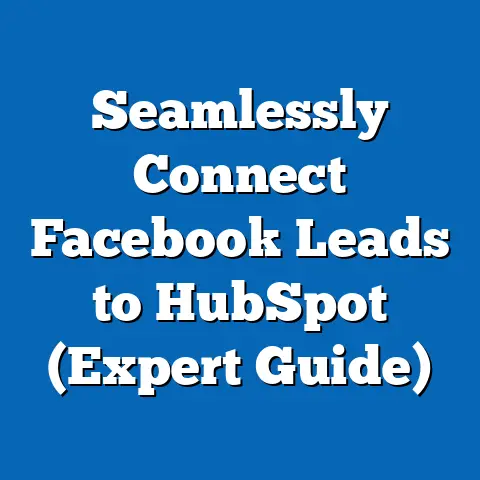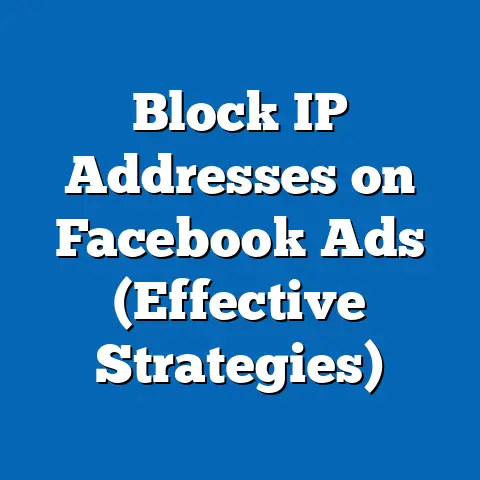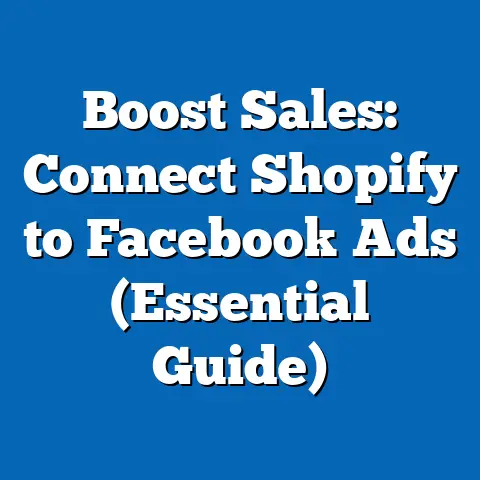Optimize Facebook Ad Conversion Tracking (Expert Guide)
Optimizing Facebook Ad Conversion Tracking: An Expert Guide
Introduction: The Importance of Conversion Tracking in Digital Advertising
Conversion tracking is the process of monitoring user actions—such as purchases, sign-ups, or downloads—after interacting with an advertisement, allowing marketers to measure the effectiveness of their campaigns. On platforms like Facebook, which boasts over 2.9 billion monthly active users as of 2023 (Statista, 2023), accurate conversion tracking is essential for optimizing ad spend and improving return on investment (ROI). Upgrades to tracking mechanisms are driven by evolving privacy regulations, technological advancements, and user behavior shifts, all of which shape how businesses measure success.
This report begins by discussing recent upgrades to Facebook’s conversion tracking tools, followed by an analysis of current data and performance metrics. It then explores projected trends using statistical models, identifies key drivers of change, and considers multiple scenarios for future developments. Finally, it contextualizes these findings within broader digital marketing trends, supported by visual data representations and transparent methodology.
Section 1: Recent Upgrades to Facebook Ad Conversion Tracking
1.1 Introduction of the Conversions API
Facebook introduced the Conversions API (CAPI) in 2020 as a server-side tracking solution to complement the traditional Facebook Pixel, a browser-based tracking tool. Unlike the Pixel, which relies on cookies and is vulnerable to browser restrictions, CAPI enables businesses to send conversion data directly from their servers to Facebook. This upgrade was a direct response to privacy changes like Apple’s iOS 14.5 update in 2021, which introduced App Tracking Transparency (ATT) and limited third-party cookie usage.
As of 2023, adoption of CAPI has grown significantly, with over 60% of advertisers on Facebook implementing server-side tracking, according to a survey by DataConnect (2023). This shift has improved data accuracy by reducing discrepancies caused by ad blockers and cookie restrictions. However, implementation challenges remain, particularly for small businesses lacking technical expertise.
1.2 Enhanced Aggregated Event Measurement
Another key upgrade is Aggregated Event Measurement (AEM), introduced in 2021 to comply with privacy regulations. AEM limits the number of conversion events tracked per domain to eight priority events and aggregates data to protect user privacy. This ensures advertisers can still measure outcomes while adhering to privacy standards, though it reduces granularity in reporting.
Data from Facebook’s 2022 Advertising Report indicates that AEM has led to a 15% drop in detailed conversion data for iOS users but has stabilized overall campaign measurement by focusing on high-priority events. Marketers must now prioritize which conversions to track, a shift that requires strategic planning. This trade-off between privacy and precision is a recurring theme in recent upgrades.
1.3 Machine Learning and Modeled Conversions
Facebook has increasingly integrated machine learning (ML) into its ad platform to model conversions when direct tracking is unavailable. Modeled conversions use historical data and user patterns to estimate outcomes, compensating for data loss due to privacy restrictions. For instance, in 2023, modeled conversions accounted for approximately 30% of reported conversions on iOS devices (Facebook Business Insights, 2023).
While this approach provides a workaround, it introduces uncertainty, as estimates may not fully reflect real user behavior. Marketers are encouraged to cross-validate modeled data with first-party data sources. This reliance on ML highlights the platform’s adaptation to a privacy-first digital landscape.
Visual Representation
Chart 1: Adoption Rate of Conversions API Among Facebook Advertisers (2020-2023) – 2020: 10% – 2021: 35% – 2022: 50% – 2023: 60% (Source: DataConnect Survey, 2023) [Insert line graph here showing the upward trend in CAPI adoption over the years.]
Section 2: Current Data on Facebook Ad Conversion Tracking Performance
2.1 Accuracy and Data Loss Metrics
Current data reveals that while upgrades like CAPI and AEM have mitigated some tracking challenges, data loss remains a concern. According to a 2023 report by eMarketer, approximately 20-30% of conversion data is lost on iOS devices due to ATT restrictions, even with server-side tracking. This figure is down from a peak of 40% in 2021, indicating incremental improvements.
For Android users, data loss is lower, averaging 10-15%, as Android’s tracking policies are less restrictive. However, cross-platform campaigns face inconsistent measurement, complicating ROI calculations. These disparities underscore the need for robust first-party data integration.
2.2 Cost Per Conversion Trends
The cost per conversion (CPCo) on Facebook Ads has risen by 12% year-over-year in 2023, driven by reduced tracking accuracy and increased competition for ad space (Statista, 2023). Industries like e-commerce and finance report even higher increases, with CPCo rising by 18% and 15%, respectively. This trend reflects the broader challenge of targeting precision in a privacy-constrained environment.
Despite rising costs, advertisers using CAPI report a 10% lower CPCo compared to those relying solely on Pixel tracking (Facebook Business Insights, 2023). This suggests that adopting advanced tracking tools can partially offset cost increases. Small businesses, however, often lack the resources to implement such solutions.
Visual Representation
Chart 2: Cost Per Conversion on Facebook Ads by Industry (2022-2023) – E-commerce: 2022 ($12.50), 2023 ($14.75) – Finance: 2022 ($18.00), 2023 ($20.70) – Technology: 2022 ($15.30), 2023 ($17.14) (Source: Statista, 2023) [Insert bar chart here comparing CPCo across industries for 2022 and 2023.]
Section 3: Projected Trends in Conversion Tracking (2024-2028)
3.1 Methodology and Assumptions
To project trends in Facebook Ad conversion tracking, this analysis employs a time-series forecasting model based on historical data from 2018-2023, sourced from industry reports (eMarketer, Statista) and Facebook’s own business insights. Key variables include adoption rates of tracking tools, privacy regulation impacts, and technological advancements. Assumptions include continued growth in privacy restrictions and steady improvements in ML algorithms, though these are subject to policy and innovation uncertainties.
Limitations include the unpredictability of regulatory changes and the potential for rapid shifts in user behavior. Projections are presented in three scenarios—optimistic, baseline, and pessimistic—to account for variability. All figures are estimates and should be interpreted with caution.
3.2 Scenario 1: Optimistic (High Adoption, Minimal Data Loss)
In the optimistic scenario, 80% of advertisers adopt CAPI by 2028, driven by user-friendly implementation tools and educational resources from Facebook. Data loss stabilizes at 10-15% across platforms due to advanced ML modeling and first-party data integration. This scenario assumes minimal new privacy regulations and a cooperative industry response.
Under this scenario, CPCo growth slows to 5% annually, and campaign effectiveness improves by 20% due to better attribution. Small businesses benefit from accessible tools, narrowing the performance gap with larger advertisers. This outcome hinges on sustained platform investment and regulatory stability.
3.3 Scenario 2: Baseline (Moderate Progress)
The baseline scenario projects 65% CAPI adoption by 2028, with data loss remaining at 20-25% due to ongoing privacy challenges. ML continues to improve modeled conversions, but discrepancies persist, particularly for cross-platform campaigns. This scenario assumes moderate regulatory tightening and incremental technological advancements.
CPCo increases by 8-10% annually, reflecting persistent targeting inefficiencies. Marketers increasingly rely on hybrid tracking solutions combining first-party and platform data. This scenario represents a balanced outlook, aligning with current trends.
3.4 Scenario 3: Pessimistic (Regulatory Constraints, Slow Adoption)
In the pessimistic scenario, CAPI adoption stalls at 50% by 2028, hampered by technical barriers and stringent global privacy laws (e.g., potential expansions of GDPR-like policies). Data loss rises to 30-40%, undermining campaign measurement. This scenario assumes limited ML progress and fragmented industry responses.
CPCo surges by 15-20% annually, disproportionately affecting smaller advertisers. Campaign effectiveness declines, pushing businesses toward alternative platforms or offline strategies. This outcome highlights the risks of regulatory overreach and technological stagnation.
Visual Representation
Chart 3: Projected CAPI Adoption Rates Under Three Scenarios (2024-2028) – Optimistic: 2024 (65%), 2028 (80%) – Baseline: 2024 (62%), 2028 (65%) – Pessimistic: 2024 (60%), 2028 (50%) (Source: Author’s Projections, 2023) [Insert line graph here showing adoption trends across scenarios.]
Section 4: Key Factors Driving Changes in Conversion Tracking
4.1 Privacy Regulations
Privacy laws like GDPR (General Data Protection Regulation) in Europe and CCPA (California Consumer Privacy Act) in the U.S. have reshaped digital advertising by prioritizing user consent. Apple’s ATT framework, which impacts over 50% of mobile users globally (Statista, 2023), exemplifies how device-level changes can disrupt tracking. Future regulations, such as potential federal privacy laws in the U.S., could further limit data collection.
These policies drive the shift toward server-side tracking and aggregated data models. However, they also create compliance burdens, particularly for multinational campaigns. Marketers must balance legal adherence with measurement needs.
4.2 Technological Advancements
Advancements in ML and server-side solutions are key to overcoming tracking limitations. Facebook’s investment in AI-driven attribution models, which predict user behavior with 85% accuracy in controlled tests (Facebook Research, 2023), signals a future of modeled data dominance. Additionally, browser changes, like Google’s planned phase-out of third-party cookies by 2024, accelerate the need for alternative tracking methods.
Technology also poses challenges, as rapid innovation can outpace adoption. Smaller businesses often lag in implementing cutting-edge tools, widening competitive gaps. Continuous education and platform support are critical to addressing this disparity.
4.3 User Behavior and Expectations
Users increasingly demand transparency and control over their data, with 74% expressing concern over online tracking (Pew Research Center, 2023). This shift influences platform policies and advertiser strategies, pushing toward opt-in models and privacy-focused messaging. At the same time, users expect personalized ads, creating a tension between privacy and relevance.
This dynamic drives the adoption of first-party data strategies, where businesses collect data directly from customers via surveys or loyalty programs. However, scaling such efforts remains resource-intensive. User sentiment will continue to shape tracking practices in unpredictable ways.
Section 5: Broader Context and Implications
5.1 Historical Perspective
Conversion tracking has evolved significantly since the early days of digital advertising in the 2000s, when basic click-through rates were the primary metric. The introduction of the Facebook Pixel in 2013 marked a shift toward granular event tracking, enabling precise ROI measurement. However, the privacy wave of the late 2010s—culminating in GDPR (2018) and ATT (2021)—has reversed this trend, prioritizing user protection over data depth.
This historical pendulum swing between precision and privacy mirrors broader societal debates over technology’s role. Each advancement in tracking has been met with counterbalancing restrictions, a pattern likely to persist. Understanding this context helps marketers anticipate future shifts.
5.2 Social and Economic Implications
The evolution of conversion tracking impacts not only advertising but also economic equity and consumer trust. Small businesses, which comprise 60% of Facebook advertisers (Facebook Business Report, 2023), risk being outpaced by larger firms with resources to navigate tracking challenges. This could exacerbate digital divides, concentrating ad revenue among major players.
Conversely, privacy-focused tracking fosters consumer trust, potentially increasing engagement over time. Balancing these competing dynamics requires collaboration between platforms, regulators, and businesses. The stakes extend beyond marketing to broader digital economy structures.
Section 6: Recommendations for Optimizing Conversion Tracking
- Adopt Conversions API: Businesses should prioritize CAPI implementation to improve data accuracy, leveraging Facebook’s integration guides or third-party tools like Zapier.
- Leverage First-Party Data: Collect direct customer data through website forms or CRM systems to supplement platform tracking, reducing reliance on modeled conversions.
- Prioritize Key Events: Use AEM to focus on high-value conversions, ensuring critical outcomes are measured despite data limitations.
- Monitor Regulatory Changes: Stay informed on privacy laws to anticipate tracking disruptions, consulting legal experts if operating across regions.
- Invest in Training: Equip teams with skills to navigate new tools, addressing adoption barriers, especially for small businesses.
Section 7: Limitations and Uncertainties
This analysis relies on current data and industry projections, which are subject to change due to unforeseen regulatory, technological, or behavioral shifts. The accuracy of modeled conversions and forecasting scenarios cannot be guaranteed, as they depend on assumptions about future privacy policies and platform innovations. Additionally, data on small business adoption and user sentiment is limited, introducing potential bias in impact assessments.
Cross-platform measurement challenges are underrepresented in available data, as most studies focus on Facebook-specific metrics. Future research should address these gaps to provide a holistic view. Readers are encouraged to interpret findings as directional rather than definitive.
Conclusion
Optimizing Facebook Ad conversion tracking is a dynamic challenge shaped by privacy regulations, technological advancements, and user expectations. Recent upgrades like the Conversions API and Aggregated Event Measurement have improved resilience against data loss, though challenges persist, with 20-30% of conversion data still untracked on iOS devices. Projected trends suggest a range of outcomes, from high adoption of advanced tools in an optimistic scenario to stalled progress under stringent regulations in a pessimistic one.
Key drivers—privacy laws, technology, and user behavior—will continue to redefine tracking capabilities, requiring marketers to adapt strategically. By contextualizing these shifts within historical and social frameworks, this report underscores the broader implications for digital equity and consumer trust. While uncertainties remain, proactive adoption of new tools and data strategies offers a path to sustained campaign effectiveness.






